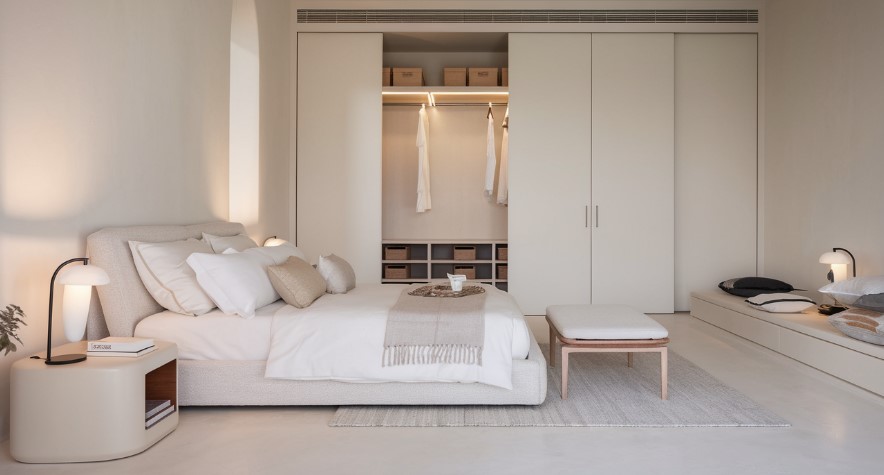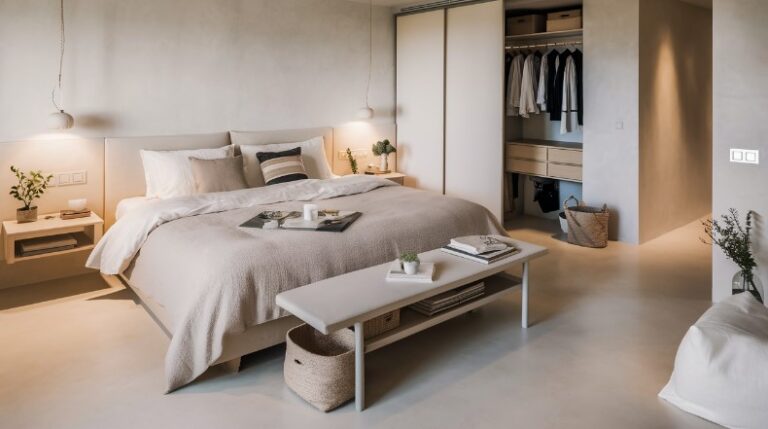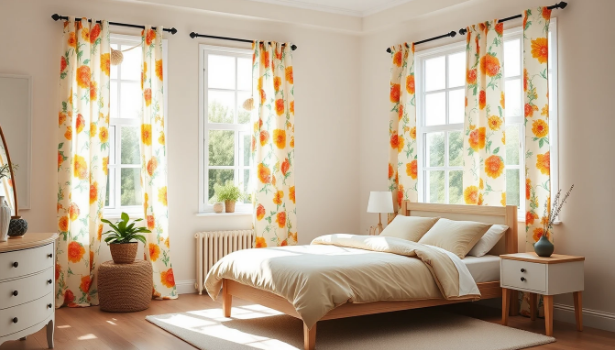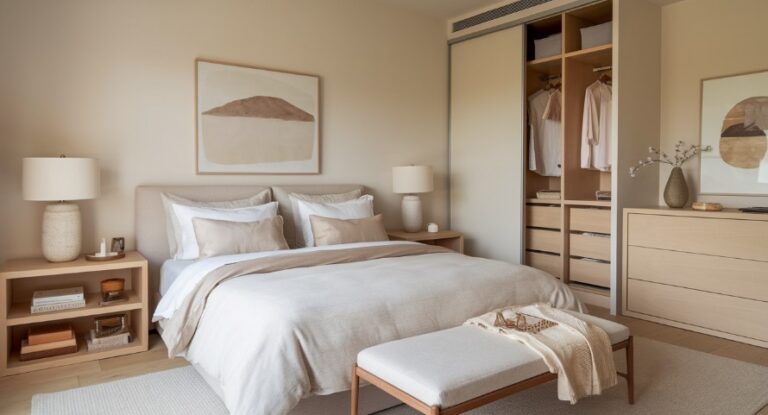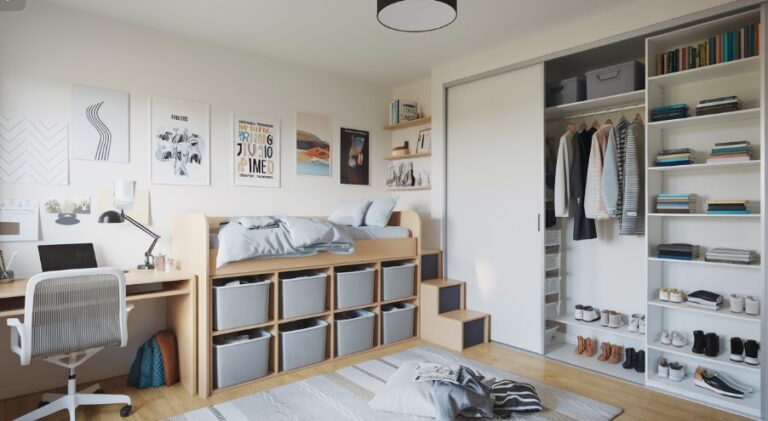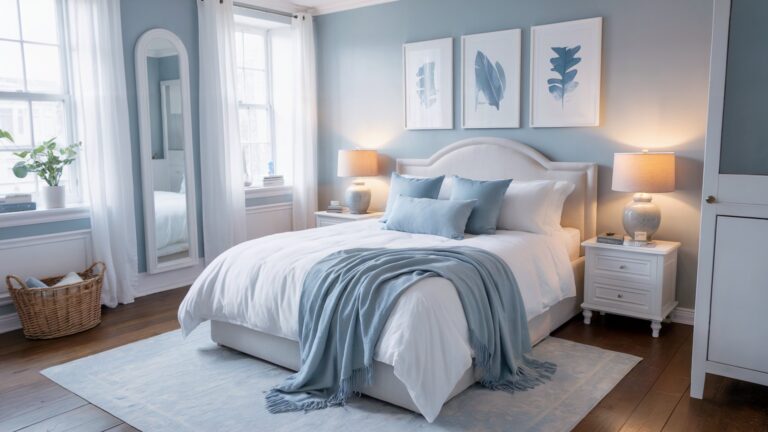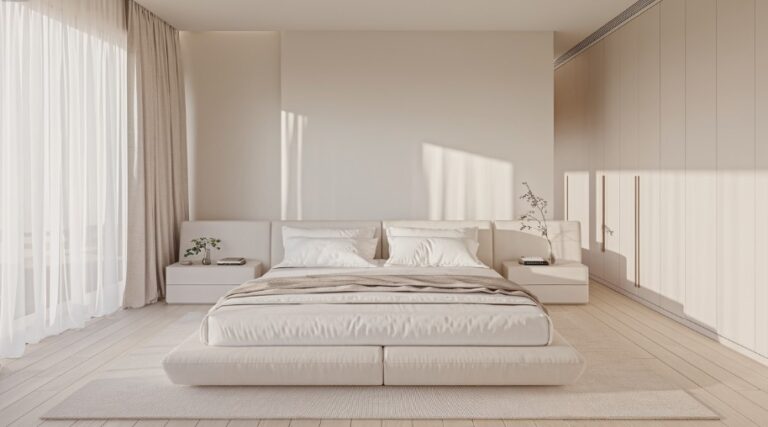Minimalist Bedroom Decluttering
Our bedrooms should be peaceful retreats. Yet, clutter can cause stress and disrupt sleep.
Adopting minimalist ideas can transform your bedroom into a calm space.
We aim to drop unnecessary items and organize what we need.
Cut down on distractions and focus on what’s essential. This fosters a better atmosphere and boosts well-being.
Join us. We’ll share tips to create a serene, nurturing sleep space.
1. Evaluate Your Bedroom Essentials
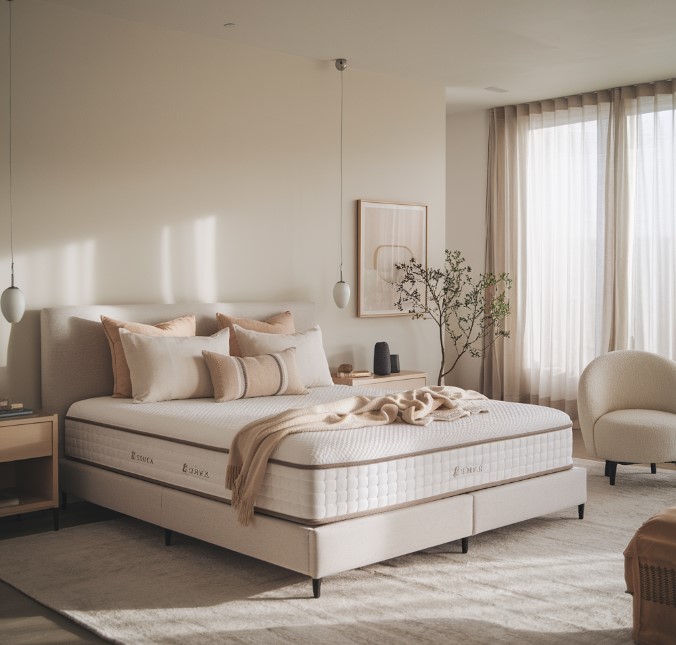
To create a calm, simple bedroom, review what’s essential. First, find items that aid comfort, like a good mattress and supportive pillows.
Next, consider each piece of furniture. Choose functional items that don’t overcrowd the space.
Then, streamline storage. Keep only what you need and use. This cuts clutter and boosts calm.
For decor, aim for simplicity. Pick a few meaningful pieces that fit the room’s vibe.
Now, consider lighting. Maximize natural light with sheer curtains. For artificial light, use soft, warm bulbs.
You can build a peaceful, minimalist bedroom for good sleep. To do that, assess these elements.
2. Declutter Surfaces and Flat Space
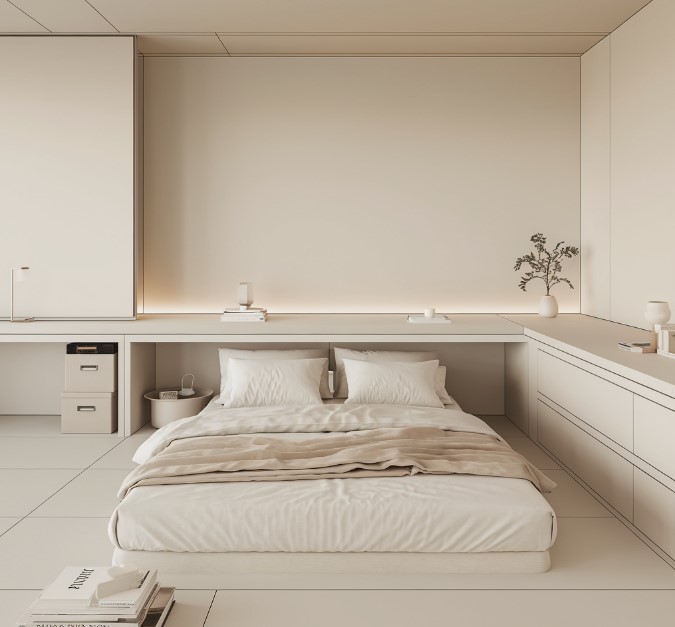
To make a minimalist bedroom, first clear all flat surfaces. This enhances relaxation and clarity.
Start with dressers, nightstands, and similar surfaces. Remove non-essential items. They shouldn’t disrupt your peace.
Adopt the “one-in, one-out” rule. For every new item, remove an old one. This applies to décor, clothing, and more.
This method stops unnecessary clutter. It also encourages thoughtful buying.
Store rarely used items in drawers or bins. This keeps surfaces clear and neat.
Choose simple, functional decor. It should add to the room’s calm, not clutter it.
By decluttering and sticking to minimalist rules, you’ll create a peaceful sleep space. This promotes better sleep and a calm mind.
3. Minimize Bedroom Decor
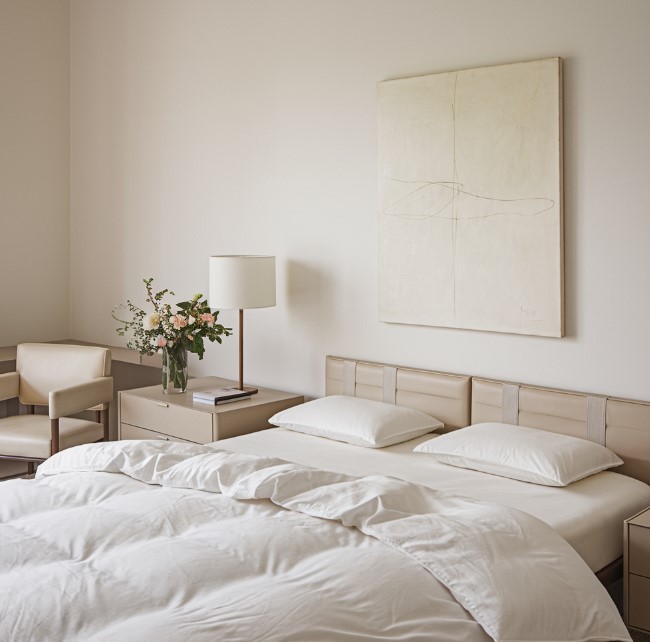
For a minimalist bedroom, curate your decor carefully. Start by minimizing the number of decorative items you display.
Less wall art, knick-knacks, and decor cuts clutter. It creates a more spacious, peaceful feel.
Choose a few items that evoke calm and serenity. They could be a framed photo, a piece of art, or a simple vase with fresh flowers.
Each item should have a purpose or sentimental value. It should enhance your sleeping space ambiance. The key is to focus on quality over quantity.
Less decor boosts the room’s beauty. It also clears the mind and improves sleep.
4. Streamline Your Closet and Wardrobe
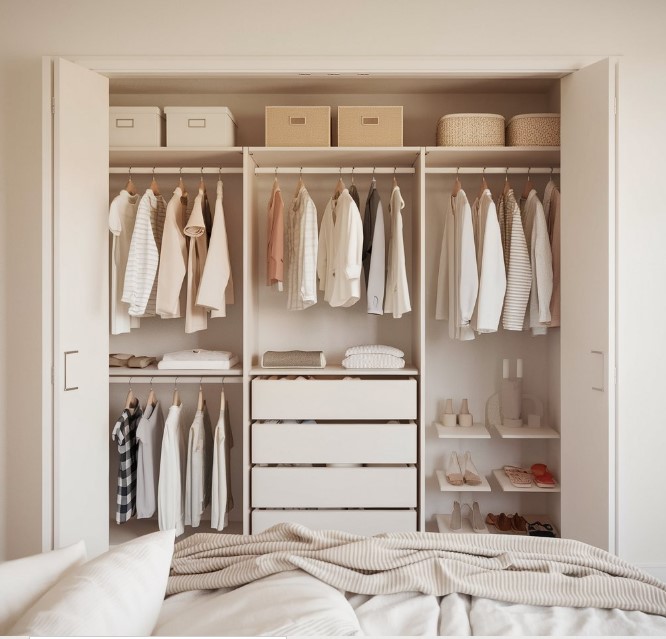
Streamlining your closet and wardrobe is a pivotal step in minimalist bedroom decluttering.
Creating a minimalist capsule wardrobe. This is where a small collection of essential clothes that mix and match easily.
Assess each item for its versatility and quality. Keep only those that fit your style and needs.
Next, organize your clothes by category and frequency of use. This approach saves space and makes getting dressed stress-free.
Store seasonal and occasional items in discreet, accessible solutions. They shouldn’t overwhelm your everyday choices.
Implementing these strategies promotes a clutter-free environment that fosters calm and focus. It also encourages mindful consumption, fostering a sustainable approach to fashion.
A streamlined wardrobe creates a functional, stylish bedroom. It supports your minimalist lifestyle and boosts your well-being.
5. Address the “Floordrobe”
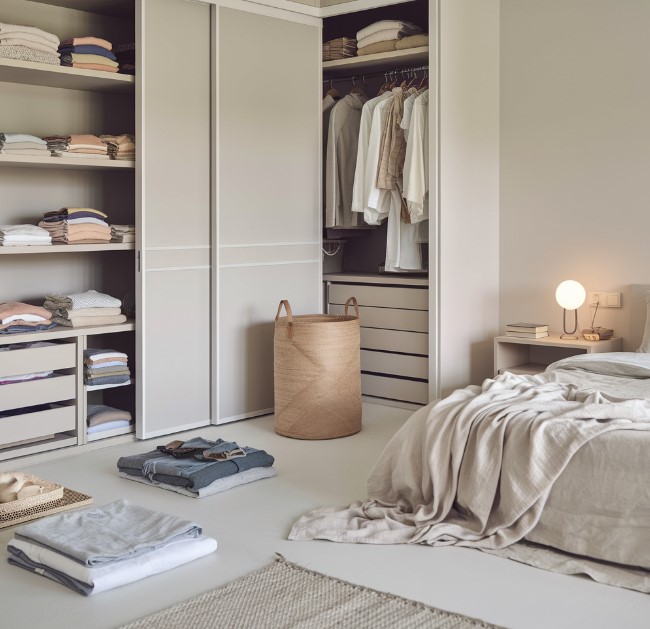
Tackling the “floordrobe” is key for a minimalist bedroom. Clothes on the floor create chaos and disrupt peace.
First, sort the clothes. Fold what’s clean. Set aside dirty clothes and items for donation.
Next, create a system to prevent floor clutter. Use drawers for folded clothes and hangers for others.
Consider a nightly tidy-up or a weekly clean-out to stay organized.
A stylish laundry hamper can also encourage putting clothes away.
Deal with the floordrobe and set up a system. You’ll gain floor space and create a calm, minimalist bedroom.
6. Eliminate Technology Distractions
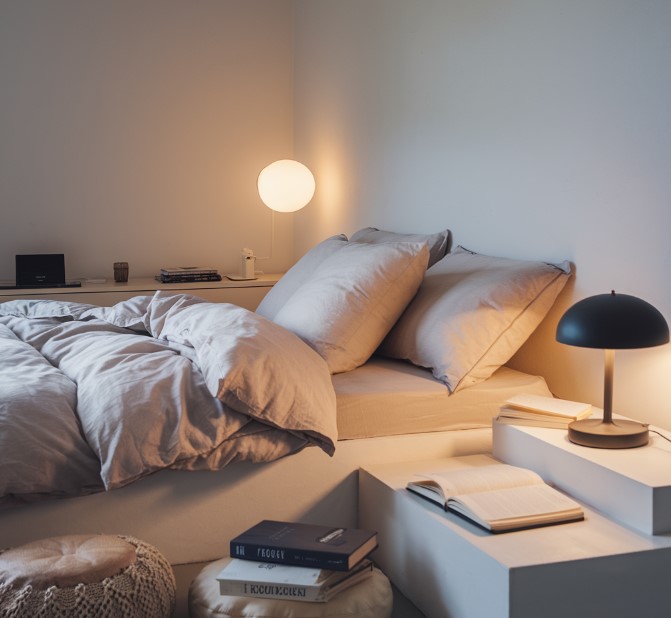
To make a minimalist bedroom, first, remove sleep-disrupting technology. Devices like TVs, computers, and smartphones emit blue light. This light lowers melatonin, a hormone crucial for sleep.
With these devices gone, your room becomes a peaceful rest area. A bedtime routine without tech can enhance calm. Try reading, meditating, or journaling instead of using screens.
Such rituals signal your body to unwind, leading to better sleep. Without screens, you’re less likely to engage in activities that keep you awake.
Eliminating technology creates a simple, mindful sleep space, boosting sleep and well-being.
7. Maintain a Decluttered Bedroom
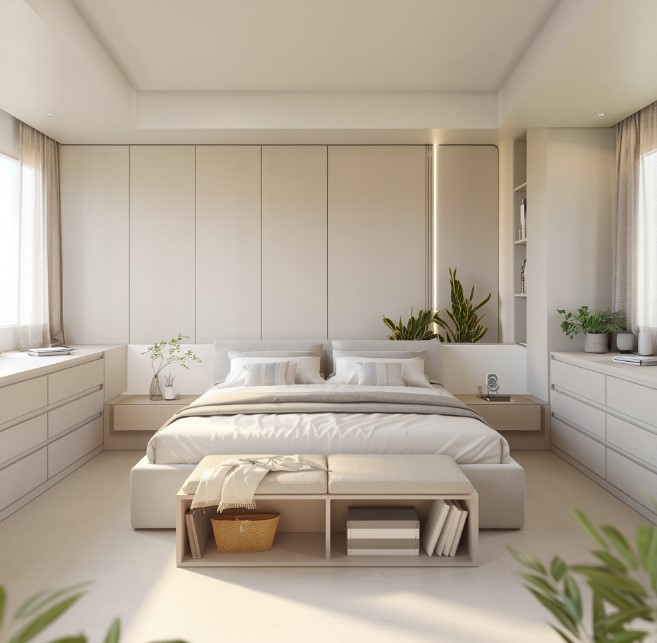
A tidy bedroom is vital for good sleep. Start daily habits: make your bed and put things away.
Check each item on a regular basis. If it doesn’t help, think about donating or recycling it.
Use smart storage that matches your simple style. Make sure everything has a spot. Choose furniture that saves space.
Avoid impulse buying. Only buy what you need.
Conduct a review of your setup on a regular basis. Adjust as needed to keep it simple.
These habits will give you a peaceful bedroom. They will help you sleep better and feel good
Conclusion
In conclusion, minimalist bedroom decluttering isn’t just about tidiness. It’s a way to create a serene sleep space that nurtures body and mind.
Prioritizing simplicity and functionality can help you. It will eliminate distractions and promote calm, restful sleep.
Decluttering and organizing your bedroom will keep it a calm, chaos-free sanctuary.
Remember, minimalist living is a journey. It needs mindfulness and intent in both consumption and organization.
A clutter-free environment will greatly boost your well-being. As you improve your space and habits, you’ll see this.
So, take the first step to a more peaceful bedroom. Enjoy a restful sleep space tomorrow.
1. How can minimalist principles improve my bedroom space?
Minimalist principles can greatly enhance your bedroom. They focus on simplicity, functionality, and calm.
Adopting minimalism helps you eliminate clutter. This creates a peaceful space for better sleep.
Minimalist decor includes only essential furniture and items. It reduces visual clutter, ensuring a clean look.
This approach not only beautifies but also simplifies cleaning.
Moreover, minimalism values purposeful use of space. Each item is chosen for its utility and beauty.
This method prevents overcrowding, keeping the room open and organized.
A minimalist bedroom also boosts mental clarity and reduces stress. A tidy space with fewer distractions helps you relax. It improves sleep and health.
In short, minimalist principles can turn your bedroom into a calm, functional sanctuary. This will boost your comfort and peace.
2. What are some common mistakes people make when decluttering their bedrooms?
When decluttering bedrooms, people often make common mistakes that hinder progress.
First, starting without a plan leads to aimless sorting. This causes overwhelm and incomplete work.
Second, holding onto items for emotional reasons prevents effective downsizing.
Third, focusing only on visible areas, like surfaces, misses hidden clutter. It ignores closets and under the bed.
Some rush the process and ignore long-term needs. This causes recurring decluttering.
Often, people fail to create post-decluttering systems, causing clutter to return.
Many underestimate the time and effort needed, leading to hasty, poor decisions.
To avoid these mistakes, you need a plan. Be honest about your needs. Tackle all areas. Create systems. And, allow enough time.
3. What are some practical tips for creating a calming, minimalist bedroom environment?
To create a calming, minimalist bedroom, follow these tips for a serene space.
Declutter, keeping only essential items visible. Store others out of sight to keep surfaces clean. Use neutral colors and natural materials for furniture and decor. They promote tranquility.
Use soft, ambient lighting and few fixtures. This avoids clutter and creates a relaxing atmosphere.
Invest in quality bedding and linens that are comfortable and enhance relaxation. Use storage solutions like under-bed bins or wall-mounted shelves. They will help you keep an organized space without overcrowding.
Use plants or natural textures to create a calming, outdoor feel.
Lastly, limit devices and screens in the bedroom. This will encourage better sleep, reduce distractions, and promote a minimalist, restful lifestyle.
4. How can I maintain a minimalist bedroom over time?
Keeping a minimalist bedroom requires regular habits and careful choices.
First, often check your items. Follow the one in, one out rule. If you add something, remove something else.
Choose simple, functional storage like bins or purposeful shelves. This helps avoid extra items.
Spend a few minutes daily to tidy up. Put everything back in its place.
Avoid buying on a whim. Aim for quality, not quantity.
Regularly check and clear spaces. Ensure each item is needed or loved.
Finally, appreciate what you have. This prevents unnecessary buying.
By sticking to these habits, you’ll keep your bedroom calm and clutter-free.
